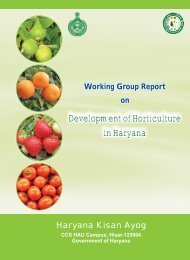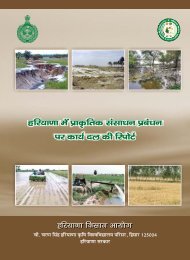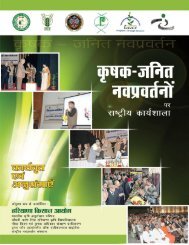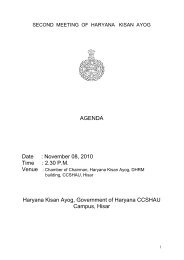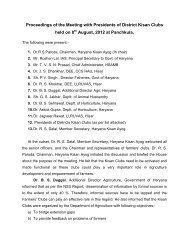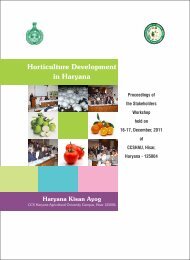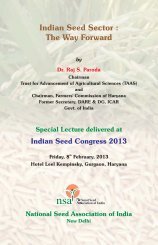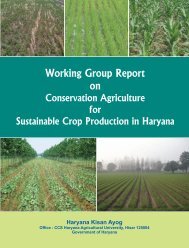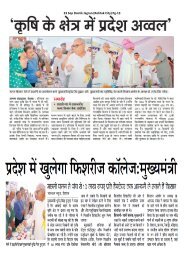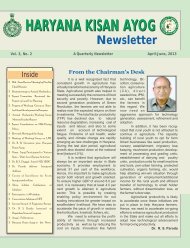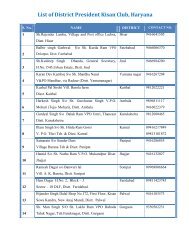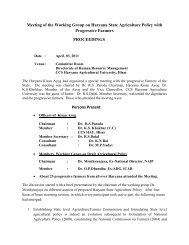Working Group Report on - Haryana Kisan Ayog
Working Group Report on - Haryana Kisan Ayog
Working Group Report on - Haryana Kisan Ayog
- No tags were found...
Create successful ePaper yourself
Turn your PDF publications into a flip-book with our unique Google optimized e-Paper software.
1.0 INTRODUCTIONFisheries and aquaculture, directly and indirectly, play an essential role in earningthe livelihoods for milli<strong>on</strong>s of people-almost 540 milli<strong>on</strong> people, or nearly 8 percentof the world populati<strong>on</strong>. Indian fisheries with producti<strong>on</strong> of 8 milli<strong>on</strong> t<strong>on</strong>nes (2009-10) occupies sec<strong>on</strong>d positi<strong>on</strong> globally with overall annual growth rate of 4.7% and6.2% growth in inland sector, thereby c<strong>on</strong>tributing 1.1% to total GDP and 5.3% toagricultural GDP. The sector engages 14 milli<strong>on</strong> people across the country and earnsmore than Rs.10,000 crores annually through exports.<strong>Haryana</strong> is primarily an agrarian land locked State with 75% of its populati<strong>on</strong>engaged in agriculture and allied activities. Its land resources, which <strong>on</strong>e graduallydeclining, are the most important and scarce resource. It is characterized by arid andsemi-arid climatic c<strong>on</strong>diti<strong>on</strong> with scanty average rain fall (455 mm/year), highseepage and evaporati<strong>on</strong> rate. With the total seas<strong>on</strong>al/l<strong>on</strong>g seas<strong>on</strong>al water area ofmere 85,900 ha c<strong>on</strong>stituting <strong>on</strong>ly 2% of the total geographical area of the State, fishculture would <strong>on</strong>ly seem rather a difficult propositi<strong>on</strong> at first. Besides, the fact that<strong>Haryana</strong> has a culturally predominant vegetarian populati<strong>on</strong> further has made fishfarming <strong>on</strong>e of the least preferred occupati<strong>on</strong>al choice. This is attested by the factthat, unlike other States, <strong>Haryana</strong> has no traditi<strong>on</strong>al fishing communities whoderive their livelihood primarily from fishing.However, as the saying goes, m<strong>on</strong>ey has neither colour nor creed. The ec<strong>on</strong>omicviability and profitability were the prime factors that motivated a few enterprisingfarmers to adopt fish culture in early 1980s, though it was a struggle c<strong>on</strong>vincingthem during initial years. C<strong>on</strong>sidering this, fisheries development has madesignificant progress in the last three decades, feeding mainly the Delhi market. At thetime of creati<strong>on</strong> of <strong>Haryana</strong> in 1966, <strong>on</strong>ly 58 hectare of village p<strong>on</strong>ds were underfish culture while total fish producti<strong>on</strong> was 600 t<strong>on</strong>nes, while India’s inlandproducti<strong>on</strong> was 5 lakh t<strong>on</strong>nes. Fish producti<strong>on</strong> shot up to 23,200 t<strong>on</strong>nes by 1990,33,040 t<strong>on</strong>nes by 2000 and nearly 1 lakh t<strong>on</strong>nes by 2010, more than 4 times duringthe last two decades c<strong>on</strong>stituting 2.1% of India’s inland fish producti<strong>on</strong>, which is nomean achievement c<strong>on</strong>sidering that the overall Indian inland producti<strong>on</strong> grew <strong>on</strong>ly( 1 )



